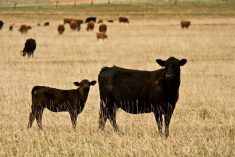Compared to last week, western Canadian yearling markets traded steady to $2 higher while calf prices were unchanged to $4 lower. Yearling supplies are limited and there appeared to be a surge of buying interest for 850-lb. thin-fleshed replacements. Alberta fed cattle basis levels for the second quarter of 2023 have above average and the April live cattle futures are near contract highs. Barley prices have also come off the highs, contributing to the firmer tone.
The calf market was quite variable across the Prairies. Demand was stable for bawlers under 550 lbs.; however, buyers had lower interest for calves in the 550- to 750-lb. category. Manitoba calves held a premium over Saskatchewan and Alberta with Ontario orders setting the price structure. This reflects the feed grain advantage compared to Alberta.
Read Also

U.S. grains: Soy futures post biggest monthly gain in nearly five years on China trade optimism
U.S. soybean futures climbed to a 15-month high and posted their biggest monthly gain in nearly five years on Friday following a rally fueled by the prospect of revived exports to China.
A larger group of large, wide-frame black steers on forage diet weighing 925 lbs. reached up to $236 f.o.b. the ranch north of Saskatoon. In central Alberta, a small package of red Angus-based heifers weighing 945 lbs. on light grain ration with full health data dropped the gavel at $198. Northwest of Winnipeg, a smaller group of larger-frame thin-fleshed Charolais steers weighing 855 lbs. silenced the crowed at $240 and similar-quality heifers scaling at 820 lbs. notched the board at $215.
In east-central Alberta, larger-frame Simmental fully weaned steers with lower flesh levels weighing 755 lbs. sold for $242 and similar-quality heifers scaling at 720 lbs. sold for $203. South of Edmonton, semi-weaned mixed steers weighing 707 lbs. were quoted at $248. In Manitoba, red mixed steers weighing 720 lbs. were bid up to $256.
North of Calgary, unweaned mixed steers weighing 630 lbs. were purchased for $256; southeast of Saskatoon, a larger group of 625-lb. tan semi-weaned steers reached up to $270; Northwest of Winnipeg, a smaller group of Limo-blended steers weighing a shade over 600 lbs. charted course at $263.
In east-central Alberta, a small group of mixed steers weighing 455 lbs. sold for $311 and a small group of Simmental mixed steers weighing 505 lbs. sold for $283. Southeast of Saskatoon, a small group of black steers weighing 495 lbs. sold for $293. In Manitoba, a small group of steers weighing 500 lbs. reached up to $296 and 430-lb. steers stunned the crowd by selling for $333.
The calf market appears to be more vulnerable to weather conditions this year and truck availability can also be a constraint. Many Alberta feedlots are holding cattle that should have been processed last month. This is a major factor contributing to the softer tone on calves in Alberta and Saskatchewan. The quality of calves coming on the market is fair to excellent. This is a demand-led market and buyers are in a difficult situation from all angles.
— Jerry Klassen is president and founder of Resilient Capital, specializing in proprietary commodity futures trading and market analysis. Jerry consults with feedlots on risk management and writes a weekly cattle market commentary. He can be reached at 204-504-8339 or via his website at ResilCapital.com.













